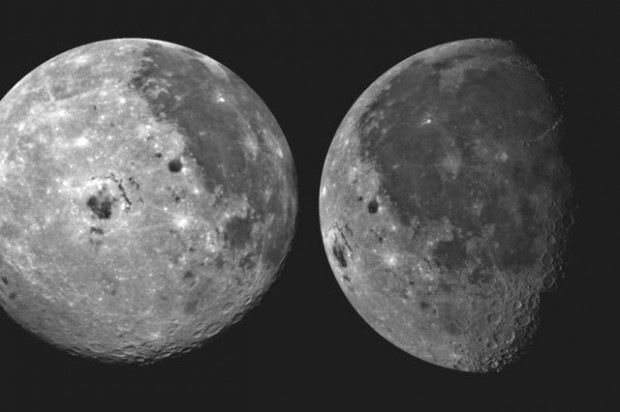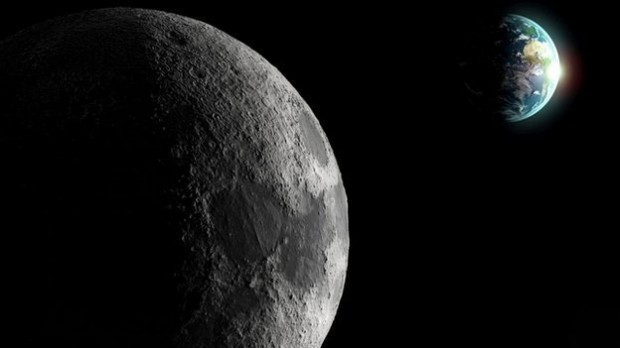با اینکه دانشمندان علم نجوم امروزی به سیاراتی بسیار دورتر از ماه نگریسته و حتی فکر قدم گذاشتن در آنها را در سر دارند اما ظاهرا هنوز هم اسراری از ماه وجود دارد تا بتواند ما را شگفت زده کند.اکنون ، یعنی 45 سال بعد از اینکه نیل آرمسترانگ قدم بر ماه گذاشت تازه دانشمندان متوجه شده اند که ماه کاملا گرد نیست !
دانشمندان می گویند ماه بیشتر شبیه به یک کره له شده همراه با یک توده مجزا است. یکی از محققان آن را شبیه به یک لیمو با یک برآمدگی استوایی می خواند. اما چرا ماه بر روی محور خود کندتر از زمین می چرخد و هیچ کدام از ساختارهای صفحه ی سیاره ی ما را ندارد، آیا ماه یک کره کامل نیست؟
گریک بتل و تیمش شکل ماه را به فرآیندی که به نام گرمایش جزر و مدی شناخته می شود نسبت می دهند که در آن نیروهای اولیه مداری بین زمین و ماه باعث ایجاد اصطکاک های داخلی بعدی می شوند و در نتیجه باعث می شود که پوسته آن در برخی نقاط به سمت بیرون کشیده شود. همینطور که این سیاره حرکت می کند و از زمین دورتر می شود و چرخش آن آهسته تر می شود این برآمدگی های جزر و مدی سفت و سخت می شود. این چیزی است که در توضیح برآمدگی های عجیب و غریب و مدرن ماه گفته می شود.
گریک بتل و تیمش قبل از محاسبه توپوگرافی ماه، از فراسنج لیزری برای ساخت نقشه های بسیار دقیق از سطح آن استفاده می کنند. استفاده از این روش به این معنی است که تیم این تحقیق اولین افرادی هستند که تصویری شفاف از شکل واقعی ماه به دست می آورند.
منبع: theverge.com
Scientists discover the moon is shaped like a lemon
Scientists discover the moon is shaped like a lemon
Although our visit to its rocky surface confirmed that it’s not covered in vast seas, it’s not home to strange moon-men, and it’s not made of cheese, the moon can still surprise us. It’s only this week that scientists have revealed that, 45 years after Neil Armstrong set foot on the planetoid, our closest celestial neighbor is not actually round.
It’s more of a squashed sphere, with a distinct lump. Ian Garrick-Bethell, who authored the study published in Nature, describes it as “like a lemon with an equatorial bulge,” or like a water balloon that flattens out as it’s spun. But why, given that it spins much slower on its axis than the Earth and has none of our planet’s plate tectonics, is the moon not a perfect sphere? Garrick-Bethell and his team instead ascribed the shape to a process known as tidal heating, in which early orbital forces between the Earth and the moon caused friction in the latter’s interior, causing its crust to expand outward in certain places. As the planetoid moved further away from our planet and slowed down its rotation, one such tidal surge was frozen in place, explaining the modern moon’s strange bulge.
Garrick-Bethell, a planetary scientist at the University of California, Santa Cruz, used a laser altimeter to create super-accurate maps of the moon’s surface, before calculating its topography. The method meant the team behind the study were the first to get a clear picture of the moon’s real shape — other scientists who have attempted the same in the past have been foiled by the sheer number of craters pockmarking the planetoid’s exterior and concealing its topographical lumps and bumps.
 گجت نیوز آخرین اخبار تکنولوژی، علم و خودرو
گجت نیوز آخرین اخبار تکنولوژی، علم و خودرو 








